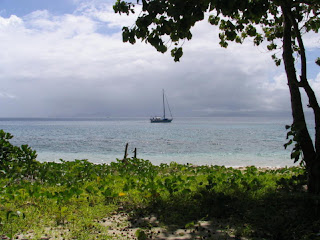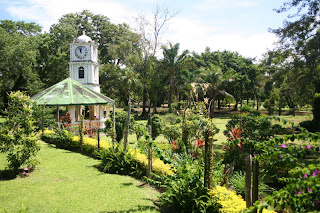 September 13-24, 2008: South Pacific
September 13-24, 2008: South PacificLuganville, Espiritu Santo, Vanuatu (S 15.32.223 E 167.10.831) http://maps.google.com/maps
All reports had said that Vanuatu would be the most undeveloped of all our destinations and for some cruisers this was the best part of the South Pacific. Spiritu Santo where Luganville is located is the largest of Vanuatu's islands. It was also suppose to be a diver's paradise with one of the largest shipwrecks in the world to be explored. We were looking forward to the passage which would take about 5 days to cover the almost 600 miles of sea. For the first two days the wind seldom got above 10 knots so we did a lot of motoring. By the third day out the wind was back and we made good way with fine weather to our first landfall Bedo Point on the island of Pentecost. Pentecost Island is where the natives dive off of high bamboo platforms with vines tied around their ankles to break their fall. The original bungee jumpers, only they used vines not bungee cord to take the plunge! We did not go ashore because we had not cleared into the country making it illegal to land. After spending the night at anchor we made the short trip to Luganville where we anchored at the custom's clearance anchorage.
.
As you can see by the pictures below the customs and immigration facilities were in need of some rehab. Basically all the government's facilities were left over buildings from WWII. Clearance was straight forward and hassle free despite the condition of the buildings.

After clearing we move across the channel to Aore Island another South Pacific paradise.

We dropped anchor just off a small resort called the Aore Resort. It was a great place to stay since we had access to their swimming pool, restaurant and ferry service to Luganville . The resort was busy but not crowded. Again it was full of mostly Australian and New Zealand tourists and a few Europeans.

Luganville itself has that sleepy tropical feel about it. During WWII it was a major base and provisioning center. At the time there was nothing but jungle and natives. By the time it was finished there were 40 cinemas, four military hospitals, five airfields, a torpedo boat base, jetties and market gardens. More than a half a million military personal were stationed here waiting to head into battle in the Pacific. As usual we were eager to see it all and do some diving. We ended up hiring a guy with his Toyota truck to show us the sights by land.


As you can see the people in the countryside have very primitive homes and some of the kids have only loin cloths. The ruins of the airbase are now mostly absorbed by the jungle and the cattle industry. The main export of Vanuatu is kava, growing in the picture on the left. They've just started a beef industry the quality of which is quite high.
.
Our guide asked me how old I was. I told him 61. He laughed and said that if I lived in Vanuatu I'd be dead by now. We all had a good chuckle but knew he wasn't joking as life was no easy thing on the island.

When the war ended the United States offered to sell its equipment to the local government but then reconsidered and decided to dump it into the sea. Million Dollar Point is where hundreds of tons of US military equipment was dumped. Everything from bulldozers, airplanes engines and jeeps to crates of Coco-Cola went into the sea, You can still see the coral-encrusted machinery and tons of broken Coke bottle glass on the shore.

We also visited a crash site where one of the returning aircraft of the war didn't make it. You could almost feel the ghosts. They said there were hundreds of sites like this on the island.

Next on the agenda was to dive the The USS President Coolidge, a luxury liner turned troop carrier, which hit a friendly mine very close to Million Dollar Point. By so doing it became the world's largest accessible and dive able shipwreck having settled at the bottom just off the shore. We were really psyched! Unfortunately because of weather the water clarity was only about 8 feet but oh what a site. It was gigantic! On the deck there were still rifles and helmets laying about. Inside dozens of jeeps. It would take multiple dives to explore the whole thing but the weather kept getting worse along with the visibility so the best site of the trip went unexplored after one dive.
We'd only been in Vanuatu a few days when one morning while charging the batteries the genset started to accelerate. I tried to shut it down from the control panel but no luck. Soon the panel lit up like a Christmas tree and black smoke started pouring out of the exhaust. The motor just kept running at higher and higher rpm. Finally after the smoke turned white, the motor stopped running. Other boats around us thought we were on fire and came to assist. When I told them that I had a run away generator one of the helpful yachties said "Its a Panda right?" He then explained he had the same problem with his Panda but replaced it before going cruising.
When I got back into the engine compartment to have a look, I discovered the seawater exhaust hose had broken flooding the sound proof case and shorting out the control electronics. The generator only had 300 hours on it, virtually new! So much for compact fully automatic gensets. There was no chance of getting it fixed in Vanuatu assuming it was still salvageable. The closest dealer was in New Caledonea four hundred miles away. Now the only way we could keep the batteries charged was by running the engine and running the engine while at anchor just to charge the batteries was not a good thing. The accumulation of these equipment problems was starting to wear me thin. If the alternator gave out we'd have no way to keep the batteries charged. After consulting with my shipmates, we decided to head for New Caledonia without lingering any further.
On September 24th we left Aore Island heading south to the Maskelyne Islands and finally Noumea in New Caledonia. Due to timing and distance we did not have a very good chance of making the Maskelyn Islands before dark so we anchored at Southwest Bay on Malekula for the night. There are too many ship wrecks out here and it is much better to be safe. From a distance this place looked desolate but soon after dropping the hook the locals showed up. It has been our experience that not very many locals come out to greet us in outriggers. The people are always friendly and usually have something to offer in the way of fruit or vegetables. Getting an up close look at the construction of the boat and paddles gives a good idea of the abilities and ambition of these islanders. All that we have seen have been wearing westernized clothing and spoke passable English. There are many cultures fading away and we have witnessed up close the blending of the old with the new. Of note, we passed an empty outrigger many miles offshore between here and Luganville. Not knowing what to do with it we left it to drift. There was one other yachtie there who asked us for the weather as they were almost out of power and had only solar charging capabilities.
On the 25th we made our way to Sakau Island in the Maskelynes. The Meskelynes are just gorgeous. The coral reefs make for excellent snorkeling. Our first sight coming into Sakau Island was a sailboat on the reef! It had run aground the night before but luckily there was another yachtie there rendering assistance. We asked if they needed any help. They said no explaining there was fishing vessel was on its way to pull the sailboat off the reef. The grounded vessel was being singlehanded and the story was the skipper fell asleep. They soon got him off the reef with almost no damage to the boat. Talk about luck.
This is where we ended up anchoring. The guy in the dugout came to tell us the best spot. He and his family lived in the hut on shore. From time to time his neighbors passed by on their way to other destinations. We gave our host some trade goods for him and his family and they in turn gave us some of the best papaya we'd tasted. They were dirt poor living a substance existence but were some of the most gracious and friendly people we came across.


We only stayed a day but could have stayed a week in this pristine setting. The generator needed fixing and I could rest until I knew it was fixed so we up anchored on September 26th to make the 411 mile passage to Noumea.

















































